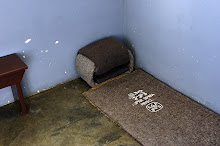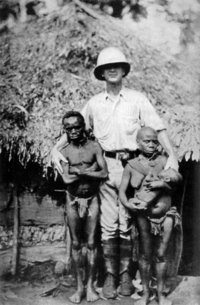
Foe is a challenging novel to read because it does not follow the structure of a typical novel. Ironically, it is a reference to Daniel DeFoe’s story of Robinson Crusoe, which was considered England’s first novel. Other than a semblance of the basic story and names of the same characters Crusoe, Friday and Foe, Coetzee’s novel veers widely from its loose counterpart. In Foe, the reader is never really sure what is real or what is imagined. The final chapter of Foe is a continuation of this enigma. Up until this last chapter, the novel is told from the perspective of Susan Barton, a woman who lives a year on an island with Crusoe and Friday as a consequence of being set afloat in a dingy from a mutinied ship. She had been on her way home from Brazil to England where she had gone to find her kidnapped daughter without success.
The last chapter can be interpreted in many ways and seems to be divided into two parts that are perhaps told by two different speakers. There is a case to be made that perhaps the first part (pages 153 –154) is either the character Foe’s beginning chapter of Susan’s story or his dream of her story. It is told in first person, which we can take to be Foe because he repeats what she has said. He says, “I begin to hear the faintest faraway roar: as she said, the roar of waves in a seashell” (154). On page 142 Susan previously tells Foe that “It is for us to open Friday’s mouth and hear what it holds: silence, perhaps, or a roar, like the roar of a seashell held to the ear.” The phrase “as she said,” indicates whoever the speaker is; he/she is referring to Susan and the same words she used. In addition, the chapter starts out as novel-like: “The staircase is dark and mean” as we remember Foe’s insistence on how a story should be told: “It is thus that we make up a book: loss, then quest, then recovery; beginning, then middle, then end” (117). The first part of this chapter begins with loss as he describes the dead bodies of a woman or girl he stumbles over and the couple that “lie side by side in bed” (153). The quest is described as he presses “closer, and with an ear to his mouth lie[s] waiting” to hear something emanate from Friday’s mouth (154). And in the final sentence, he recovers “the sounds of the island” (154). Here we find Coetzee perhaps intimating that we are complicit in requiring our stories to have a beginning, middle and end. To be entertaining and understandable. This chapter seems to encompass the book's narrative in a compressed metaphor. In this first part of the final chapter, Coetzee is perhaps demonstrating how European novels implicate linear thinking and that this is very limited and stereotyped. The best that Foe could do was show us that Friday was a part of and metaphor for the island. And by implication, that even the best intentioned member of a colonized society can only see the other from their own superficial and limited perspective within the limitations of their language.
In the second half of the last chapter, we might say that this is Susan Barton telling us her dream; perhaps a dream she had told Foe, which might clarify the similarities in observations but different perspectives in both parts of this final chapter. Whereas in this second half, Susan’s story is more subtle and expansive than Foe’s in its portrayal in the first part. This is interesting in light of the fact that Susan says she cannot write as well as Foe and enlists him to make her story interesting. Foe says: “We must make Friday’s silence speak, as well as the silence surrounding Friday,” and Susan responds: “But who will do it?” (142). In this last part of the last chapter, it is Susan who tells the story and inscribes Friday with a metaphor that goes beyond anything language can say. Out of his mouth “comes a slow stream…[that] flows…out…washing the cliffs and shores…runs northward and southward to the ends of the earth…” (157). What is the symbolism of “this slow stream?” Whatever it is, it comes from deep inside Friday. It is his story. It is “the other’s” story that lay hidden in the silence of the bodies of the oppressed, in the abused and mutilated bodies. They are the signs and the signifiers more powerful than any language. This is the world that we choose or are taught not to see. This is the world that is a murky and dark place filled with complexity. “This is not a place of words…This is a place where bodies are their own signs. It is the home of Friday” (157). Coetzee’s implication is that we cannot tolerate dark, murky stories with no ending or complete understanding. That it is the bodies and voice of the feminine, the other or the dispossessed that lie as deep as the ocean from our awareness, possessing horrible, sublime, real and valuable stories to tell in ways that are not understood because of the hegemony of the European white man’s version of history.
We can make the hypothesis that it is Susan’s point of view in this second part of the last chapter because of certain references to prior observations and word choice. For example, she uncovers what appears to be a letter to Foe with the first sentence that begins the book, “’Dear Mr Foe, At last I could row no further’” (155). In the next sentence, she describes herself “with a sigh, making barely a splash, I slip overboard,” which again refers us back to the beginning of the story being told by Susan about how she came to the island (155). She again uses the same words “With a sigh, with barely a splash”(155) she plunges into the depths of the ocean and begins to describe a dream world that is submerged, dark and complex. Earlier Foe refers to kraken as “a beast…lying on the floor of the sea”(140), and in this part Susan says, “If kraken lurks anywhere, it lurks here…” (156). We might surmise that Foe is complicit in inspiring these visions as he is in trying to get her to tell her story his way. In this way, Coetzee makes us question where the authority is to tell the stories. How are we swayed by our circumstances, our culture, and our own doubts?
However, Foe asks Susan: “‘And do you meet with phantoms in your sleep?’ ‘I dream, but I do not call the figures phantoms that come to me in dreams.’ ‘What are they then?’ ‘They are memories, memories of my waking hours, broken and mingled and altered.’ ‘And are they real?’ ‘As real, or as little real, as the memories themselves’”(138). This is interesting as we muse on Coetzee’s, perhaps, purposeful tactic that ultimately creates the suspicion of whether all of the previous part of the book leading up to this second half of the last chapter isn’t also just a dream of Susan’s. Where does something begin and another thing end? In this respect, this is also a story about boundaries, both real and invisible. And again we ask where is the authority to tell our stories? Who tells them, how are they to be told and what memories do we rely on for truth? Perhaps Coetzee has positioned his readers more to ask questions than to find answers.










